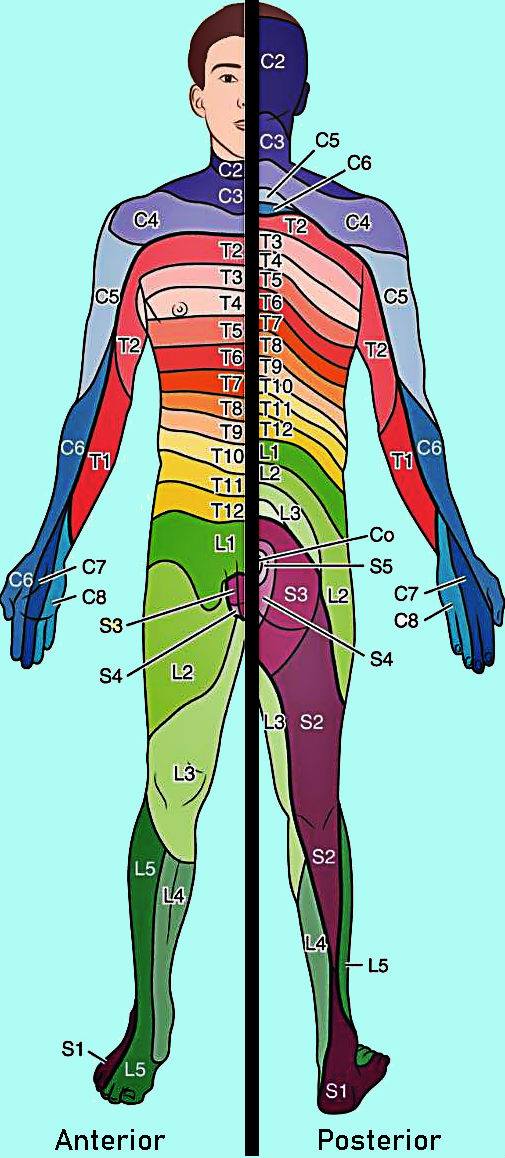By Dr. Jennifer Hubball and Dr. Marcus Judge
Next Lesson - The Brachial Plexus
Abstract
Dermatomes and myotomes are areas of skin and muscle supplied by a single spinal nerve.
Spinal nerves C1 to C7 originate above their associated vertebrae. C8 originates between C7 and T1 as there is no C8 vertebrae. Spinal nerves from C8 and below exit the spine below their corresponding vertebrae.
Core
Dermatomes and myotomes are areas of skin and muscle supplied by a single spinal nerve. A sound understanding of dermatomes and myotomes is key in for localising spinal cord pathologies, understanding and locating referred pain and understanding the impacts of damage to particular nerves. Examining myotomes and dermatomes (and being aware of where they are located on the body) is a key part of a neurological examination, particularly when a patient has a suspected spinal cord injury.
Basic Development of the Spinal Cord
By the end of the fourth week of development, the two edges of the neural folds have joined together over the neural groove, forming the neural tube. This process of forming the neural tube is known as neurulation. The neural tube will develop to form the central nervous system. Some of the ectodermal cells migrate as neural crest cells, which gives rise to some structures of the peripheral nervous system.
As the neural tube is forming, the paraxial mesoderm (sections of mesoderm that align next to the neural tube) separates into blocks called somites. These somites further differentiate into sclerotomes and dermatomyotomes. The sclerotomes give rise to vertebrae and ribs. Dermatomyotomes gives rise to the dermis via the dermatomes, and the muscle tissue via the myotomes.
Because the somites are associated with the neural tube, dermatomyotomes are associated with a specific levels of the neural tube. This means the structures formed from each dermatomyotome will take their nerve supply from an individual spinal cord segment of the neural tube. This means that the skin and muscle derived from a single dermatomyotome have a common spinal nerve supply, creating dermatomes and myotomes.
When a baby is born, the spinal cord takes up the whole vertebral column. However, as the baby grows into an adult, the vertebrae enlarge much more than the spinal cord can grow. This means that by the end of development, the spinal cord runs from the medulla oblongata in the brain to the conus medullaris at the L2 spinal level. As a result, the spinal nerves which exit below L2 are stretched out into a structure known as the cauda equina, so they can still emerge from the spinal cord underneath the correct vertebrae.
The spinal cord gives off of 31 pairs of spinal nerves (8 cervical, 12 thoracic, 5 lumbar, 5 sacral, 1 coccygeal), which exit the vertebral column according to their position in the spinal column. Spinal nerves C1 to C7 originate above their associated vertebrae. C8 originates between C7 and T1 as there is no C8 vertebrae. Spinal nerves from C8 and below exit the spine below their corresponding vertebrae.
A dermatome is an area of skin supplied by a single spinal nerve. There are two different variations of a dermatome map, but in this article we will use the Foerster map, as this is more commonly used in clinical practice.

Image showing the pattern of dermatomes on the body.
Source: Creative Commons 4.0, Wikimedia.
A myotome is a group of muscles supplied by a single spinal nerve. This is different to a motor unit, which consists of a motor neuron and the skeletal muscle fibres that it innervates.
The movement-related myotome functions for the upper and lower limbs are listed below:
C5: shoulder abduction and external rotation
C6: elbow flexion, wrist extension, and supination
C7: elbow extension, wrist flexion, and pronation
C8: finger flexion and extension, and thumb extension
T1: finger abduction and adduction
L2: hip flexion
L3: knee extension, and hip adduction
L4: ankle dorsiflexion
L5: great toe extension, and hip abduction
S1: ankle plantar-flexion
S2: knee flexion, and great toe flexion
Some other key functions of spinal nerve myotomes, alongside some helpful mnemonics for remembering them are:
- S2,3,4 innervate the continence muscles (bowel, bladder, sex organs, anal sphincter)
- Remembered as “S2,3,4 keep the s*** off the floor”
- C3,4,5 innervate the diaphragm
- Remembered as “C3,4,5 keep the diaphragm alive”
Edited by: Dr. Ben Appleby and Dr. Maddie Swannack
- 31534

